Small Home Gazette, Fall 2020
The Great Minnesota Get-Together
Did you miss going to the Minnesota State Fair this year?—the sights, the sounds, the smells, the food! We look forward to many things at the fair that had their beginnings in the bungalow era.
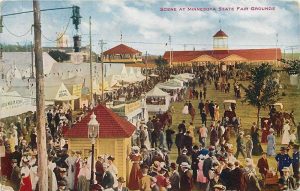
A 1910 postcard depicting the Minnesota State Fairgrounds
Our early state fairs were dominated by agricultural exhibits and competitions, reflecting their original purpose of supporting farming. The Minnesota Agricultural Society, founded in 1854, had a mission to promote the Minnesota Territory’s agriculture.
The Society sponsored an annual fair that, with the 1858 granting of statehood, became the first Minnesota State Fair in 1859. In 1885, the State Fair found a permanent home at its present location in Falcon Heights, and the space grew to its current size of 322 acres.
Since its beginning, our State Fair has been cancelled only six times: 1861 and 1862 due to the Civil War and the U.S.-Dakota War; 1893 because of scheduling conflicts with the World’s Columbian Exposition in Chicago; 1945 due to federal government travel restrictions during WWII; 1946 due to a polio epidemic; and most recently, in 2020 due to the COVID-19 pandemic.
Bungalow Era Highlights
-
1897: The Hamline Church Dining Hall opened as a food stand. By the early 1900s, it was a dining hall with its own building.
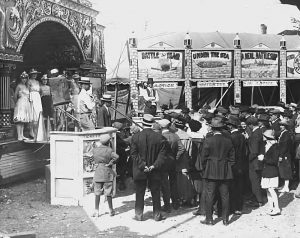
Sideshows at the Minnesota State Fair, 1917. Image courtesy of Minnesota Historical Society.
- 1899: The first year with electricity, meaning the fair could operate after sunset and could have the first evening Grandstand show with fireworks.
- 1901: Vice President Theodore Roosevelt made his famous “Speak Softly and Carry A Big Stick” speech at the Grandstand.
- 1904: The first appearance of a carnival—the first Midway.
- 1906: Dan Patch, a harness racehorse, set the world record for the mile.
-
1907: Land was purchased north of the fairgrounds to establish “Machinery Hill.” The Dairy Building (now called the Fine Arts Center) and the Poultry Building were built.
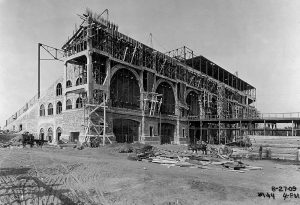
Construction of the current grandstand, 1909. Image courtesy of Minnesota State Fair photo gallery.
- 1909: Replacing an earlier two-decked wooden structure, a larger grandstand was built (bleachers were added in the late 1930s).
- 1913: Boys and Girls Clubs (later to become 4-H) exhibited at the fair. The Minnesota State Fair Board provided exhibit space and $200 in prizes for club corn exhibits.
-
1915: A carousel with 68 hand-carved horses and two chariots was installed, and Ye Old Mill was a new ride.
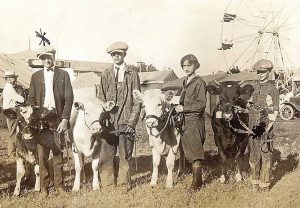
4-H club members in Houston County prepare for competition at the Minnesota State Fair. Image courtesy of Houston County Historical Society.
- 1920: The Livestock Pavilion, now known as the Cattle Barn, was completed. A massive brick structure, it could house 1,000 head of cattle (and in WWII, was used to manufacture aircraft propellers).
- 1927: John Philip Sousa debuted his “Minnesota March” at the fair.
“Firsts” at the State Fair
Meatballs and Hamloaf
In 1897, women from the Hamline Church Ladies Aid Society sold sandwiches and cold drinks to raise money for the church. The food stand was in a larger building with other attractions, but by the early 1900s, the church had a dining hall in its own wooden building.
Fairgoers enjoyed meals served on white linen tablecloths, taken home every night to be washed by hand and ironed. Fresh flowers were on every table.
The Hamline Church Dining Hall is the oldest food concession at the State Fair. The menu still offers baked chicken, Swedish meatballs, and their signature dish—hamloaf.
The Beginning of the “Big Stick”
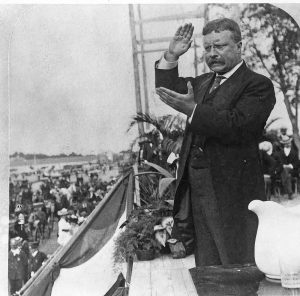 On September 2, 1901, Vice President Theodore Roosevelt gave the opening address at the Minnesota State Fair to about 10,000 people at the Grandstand. The speech is credited as Roosevelt’s first public use of his famous foreign policy tagline: “Speak softly and carry a big stick.” Roosevelt was sworn in as the country’s 26th president less than two weeks later when President William McKinley was shot at the Pan-American Exposition in New York and died from his wounds.
On September 2, 1901, Vice President Theodore Roosevelt gave the opening address at the Minnesota State Fair to about 10,000 people at the Grandstand. The speech is credited as Roosevelt’s first public use of his famous foreign policy tagline: “Speak softly and carry a big stick.” Roosevelt was sworn in as the country’s 26th president less than two weeks later when President William McKinley was shot at the Pan-American Exposition in New York and died from his wounds.
The Amazing Dan Patch
On the fairgrounds, Dan Patch Avenue is named after one of the biggest sports legends of the early 20th century: Dan Patch, the harness racehorse whose world record for fastest paced mile stood for 50 years.
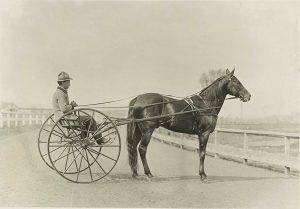
Dan Patch harnessed to a two-wheeled cart called a sulky. Image courtesy of Minnesota Historical Society.
Harness racing was a big deal in the late 19th and early 20th centuries. Trained as a pacer, Dan Patch won his first harness race in Indiana. Daniel Messner Jr., his owner, signed him up for the 1901 Grand Circuit, harness racing’s top events nationwide. The horse won all 12 races.
The horse’s third owner was Marion W. Savage, owner of the International Stock Food Company of Minneapolis. Because of the horse’s success at the track, owners refused to race their horses against him. Savage decided to have his horse race the clock. Man and horse began traveling around the country, visiting state fairs. On September 4, 1906, in front of 90,000 people at the Minnesota State Fair Grandstand, the horse broke his own world record for a paced mile, clocking in at 1:55:00.
State Fair Carousel
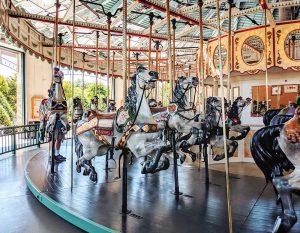
The beautiful, antique wooden carousel now operates seasonally in a Victorian pavilion near the Conservatory in St. Paul’s Como Park.
The State Fair carousel was installed on the fairgrounds in 1915. Built by the Philadelphia Toboggan Company, the carousel had four rows of 68 hand-carved jumping horses and two chariots. The music came from a Wurlitzer band organ.
The carousel spent its first 75 years at the Minnesota State Fair, run as a concession by original owner Austin McFadden and later owner-operators. Fairgoers thought the State Fair owned the carousel and assumed it would be at the fair forever. In 1988, the fair’s board refused to extend the lease for the space, and the carousel was dismantled. The idea that the carousel would be lost to Minnesotans prompted a successful public effort to save it. After restoring it and rebuilding the Wurlitzer organ, the carousel opened in Como Park in 2000.
A Gentle Ride
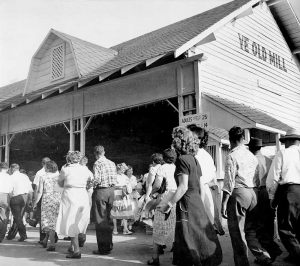 One of the oldest rides on the fairgrounds, Ye Old Mill, was built in 1915. The ride was (and still is) a series of dark tunnels that fairgoers floated through on a small boat. Built as a 971-foot concrete trough, with 15 inches of water at the start and 35 inches at the end, the trough held about 60,000 gallons of water. The 11 boats were brought out of the water and put back in by a mechanism based on a farm implement: the manure spreader.
One of the oldest rides on the fairgrounds, Ye Old Mill, was built in 1915. The ride was (and still is) a series of dark tunnels that fairgoers floated through on a small boat. Built as a 971-foot concrete trough, with 15 inches of water at the start and 35 inches at the end, the trough held about 60,000 gallons of water. The 11 boats were brought out of the water and put back in by a mechanism based on a farm implement: the manure spreader.
An Original March for Minnesota
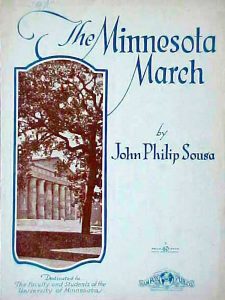 It is difficult to imagine any institution refusing a composition by John Philip Sousa but this happened in the summer of 1927. Clarence W. Spears, football coach for the University of Minnesota, verbally requested a march from Sousa, followed by a formal request from the alumni organization.
It is difficult to imagine any institution refusing a composition by John Philip Sousa but this happened in the summer of 1927. Clarence W. Spears, football coach for the University of Minnesota, verbally requested a march from Sousa, followed by a formal request from the alumni organization.
When the time came for the dedication of the march at the Minnesota State Fair on September 3, 1927, Lotus D. Coffman, president of the University, was asked to accept Sousa’s manuscript. He refused, believing the march should be presented at a University event and not at the State Fair. But the dedication ceremony went on as planned with the State Fair president doing the honors, and fairgoers enjoyed the toe-tapping “Minnesota March,” played by John Philip Sousa and his band.
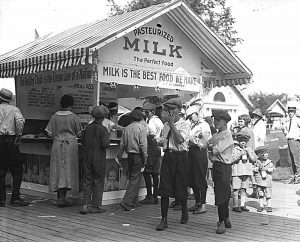 The Minnesota State Fair appears to have always been a feast for the senses with ever-growing attractions offered to fairgoers. I wonder if “people-watching” was as popular in the bungalow era as it is now.
The Minnesota State Fair appears to have always been a feast for the senses with ever-growing attractions offered to fairgoers. I wonder if “people-watching” was as popular in the bungalow era as it is now.
State Fair Hamloaf
The hamloaf was, and still is, an ever-popular menu item at Hamline State Fair dining hall.
- 1 1/2 pounds ground ham
- 1 1⁄2 pounds ground beef
- 3 c. dry breadcrumbs
- 1 small onion, chopped
- 1⁄2 tsp. salt
- 1⁄2 tsp. pepper
- 1⁄2 tsp. curry powder
- 1⁄2 tsp. ground sage
- 1⁄2 tsp. allspice
- 2 c. milk
- 3 eggs, slightly beaten
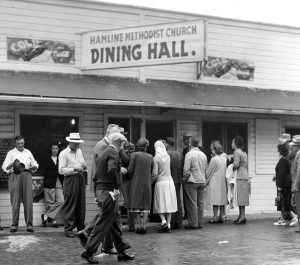 Sauce:
Sauce:
- 2 c. brown sugar, packed
- 2/3 c. vinegar
- 1⁄4 c. prepared mustard
Bring this mixture to a boil and stir until contents are well mixed.
Preheat oven to 325°. Combine all ingredients except for sauce; pack mixture into large loaf pan. Combine sauce ingredients; spoon half of sauce over loaf. Bake for 1 ½ hours. Spoon remaining sauce over loaf; continue baking 30 – 45 minutes.
This recipe is from the Hamline Cookbook.











